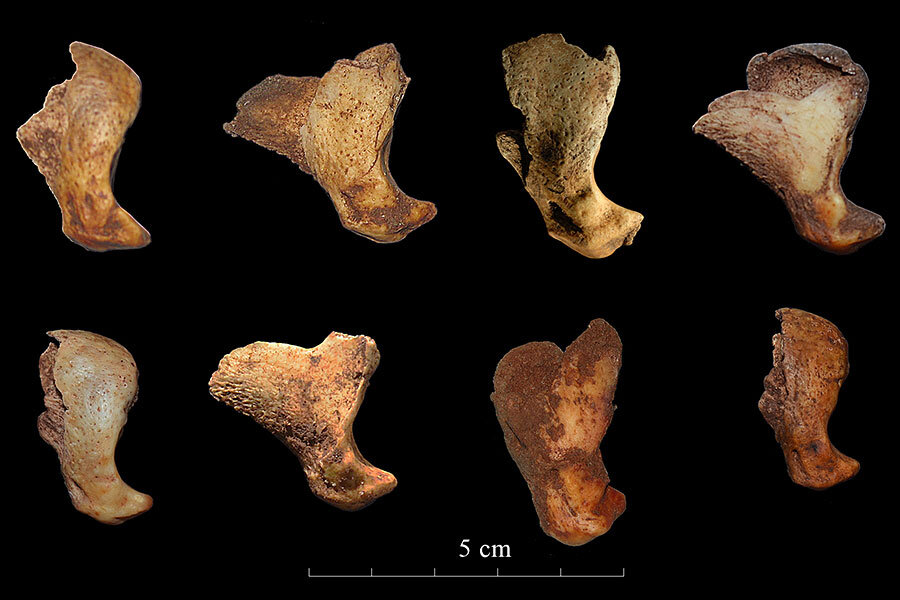Ancient interior decorators: Did early humans line caves with lion pelts?
Loading...
Some 16,000 years ago a big cat died. Today, its toes may provide insight into its species' extinction.
The cave lion, Panthera spelaea, once roamed from Europe to northern North America. Scientists think the animal was much like its modern African counterpart and hunted large animals like deer and bison. But about 12,000 ago or so, cave lions vanished from the landscape.
Scientists have suggested that changes in climate drove P. spelaea to extinction, but a study published Wednesday in the journal PLOS ONE suggests that might not be the whole story.
"Humans could have played a much more active role in the extinction of this animal," study lead author Marián Cueto, an archaeologist at the University of Salamanca, writes in an email to The Christian Science Monitor.
Humans and cave lions hunted the same animals, which could have made it difficult for the two species to share the same landscape.
But Dr. Cueto and her colleagues found evidence that might suggest humans played a more direct role in the demise of the big cats: distinctive marks on cave lion bones.
The bones, discovered in a cave on the northern coast of Spain, bear cut-marks emblematic of "expertise skinning lions," Cueto says. "They had knowledge of the anatomy, where to cut in the exact place."
And because these cut-marks seem to be made by an adept tool-user, this suggests humans were skinning lions surprisingly often, she says.
The researchers found just nine cave lion toe bones and no more of the animal's skeleton. If these cave-dwellers had hunted the animal for dinner, they likely would have dragged the whole thing back home. So perhaps the animal died and was skinned elsewhere.
But why did the toe bones make it back? The cut marks are consistent with those made when modern hunters and taxidermists want to keep an animal's claws attached to the hide, the researchers say. And, based on where the bones were found in relation to stone structures constructed in the cave, they suspect the hides were ultimately stretched across either the floor or roof of huts built by these primitive humans.
The cave lion bones were found among the remains of other large carnivores, like bears, that also display evidence of human use. This, the researchers say, suggests these humans were skillfully hunting dangerous game.
But Craig Packer, director of the Lion Research Center at the University of Minnesota who was not part of the study, isn't so sure. "Unfortunately," he writes in an email to the Monitor, "there is no evidence of how the lion died – the people occupying the cave may have found it dead from natural causes. Lions quite frequently kill each other during territorial disputes, and make an enormous amount of noise during their fights, so people could have ventured forth to collect the body after it was already dead."
Adrian Treves, founder of the Carnivore Coexistence Lab at the University of Wisconsin–Madison who was also not part of this research, agrees that these fossils do not shed much light on the story of cave lions' extinction.
"The authors deserve praise for their meticulous examination of the foot bones of an extinct cave lion, which were indisputably processed by pre-agricultural humans," he writes in an email to the Monitor. "However I doubt we can reliably infer much about cave lion extinction from this find."
Dr. Packer thinks it's unlikely that humans played a direct role in the cave lions' extinction. Instead, he suggests, it was likely a suite of challenges, including climate change and humans' improved hunting skills and tools targeting the same prey as the lions.
But these cave lion toe bones could still say something about the cavemen of 16,000 years ago, he says. "Whether or not this particular specimen was actually killed by people, the fact that it occupied such a central place in the floor of that cave illustrates that it played an important role in the minds of those people."
Cave lions, despite their name, didn't just prowl caves. The animal has sometimes been called a steppe lion because it largely hunted across open grasslands. The ancient feline is indeed a lion, however. Panthera spelaea, or sometimes Panthera leo spelaea, is an extinct relative, or possibly a subspecies, of the modern lion, Panthera leo.
Last year two frozen cave lion cubs were found in Siberian permafrost, giving scientists the first glimpse of the animal in the flesh. Before these kittens were discovered, the species was only known from bones, tracks, and cave drawings.








